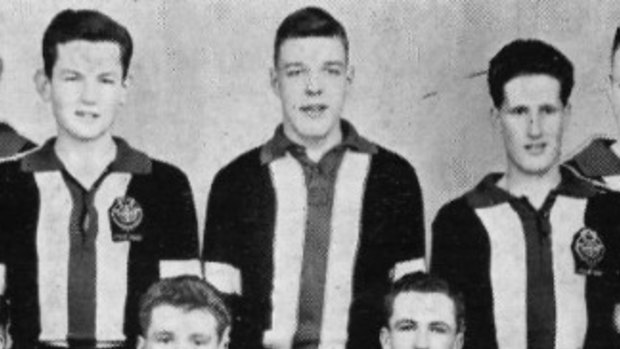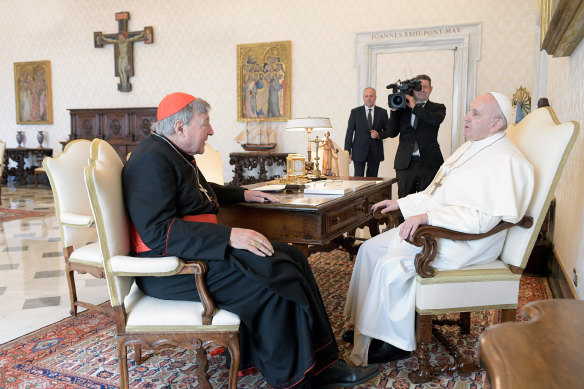Every clash I had with George Pell made me wish I had the umpire’s whistle

I first met George Pell on the football field in the early 1960s. There were several colleges for trainee priests in Melbourne in those days and all played Australian rules. In this particular game, it was men training to be local clergy versus those training in religious orders.
It was a social game, but it was tough. Pell was a ruckman for the Melbourne team and I was the umpire. He was a very good footballer, but very rough. I awarded quite a few free kicks against him.
George Pell (centre) in the team photo for St Patrick’s College 1956 First XVIII.
That set the tone for our relationship. We didn’t really know each other personally; most of our encounters were in conflictual situations debating the direction Australian Catholicism should take.
Pell was ordained in Rome in 1966; I was ordained in Melbourne in 1967. Our clerical careers took us in different directions until the visit to Australia of Pope John Paul II in 1986, when we both became prominent in the media.
By then, Pell was convinced that if the church was to have a future, it would have to maintain a fortress Catholicism that was “the one, true church” founded by Christ. It was guided by an infallible pope; it never changed its doctrines and its structure was divinely ordained. It was triumphalist Catholicism in which there was no room for questions or compromise. The church was there to teach the secular world the truth, not to learn from it.
Cardinal George Pell had a close relationship with the Pope. The pair shared a private audience in 2020 after Pell’s acquittal over sex abuse allegations.Credit:Vatican News/AP
The clerical priesthood was very important to Pell. I still remember him on ABC TV saying that Christ established the priesthood at the Last Supper as though Jesus actually set up seminaries to train clergymen in the modern sense. When I challenged this historically, he scorned the idea. For him, priesthood was of divine origin and unchanging.
Between 1966 and 1986, Pell had become the consummate churchman. Educated in Rome, he had made excellent Vatican connections, had mastered Italian and understood the Roman way of doing things — what was called Romanita.
In contrast, I was a typical “Vatican II priest”. Having worked in parish ministry and tertiary teaching in Australia and the United States, I had become convinced that Catholicism had to continue applying the reforms begun by the Second Vatican Council (1962-1965). Vatican II developed a dynamic understanding of Catholicism that was opening up to the contemporary world and even learning from it — “throwing open the windows” as Pope John XXIII put it.
Over the years in several books, I argued for a humbler church that engaged with the world and with the preoccupations of secular Australia. This led to George and I often being protagonists in the media, arguing for what seemed almost like a different church. Only then, I didn’t have the umpire’s whistle.
A pivotal event occurred just after our ordinations: Pope Paul VI’s condemnation of artificial contraception in July 1968 in the encyclical Humanae Vitae. Catholics of fertile age were forced to make a decision: either use the pill, or obey the pope and face constant fertility. Or they could use the so-called rhythm method (also called “Vatican roulette”). Pell supported Paul VI. I was a dissenter.
Revelations this week that Pell wrote a piece under a pseudonym criticising Pope Francis as a disaster and catastrophe came as little surprise to me. Pell’s stance on an infallible pope only seemed to apply when it was a pope who agreed with him.
The memo – which was published last year under the pseudonym “Demos”, meaning “the people” in Greek – detailed a scathing list of what the author saw as the failures of current Vatican leadership.
It accused Francis of silence on moral issues such as the war in Ukraine, human rights in China and a push to open the church to women priests, and argued that papal writings demonstrated an intellectual decline from the standard of John Paul II and pope Benedict.
Pell’s apparent belief that he was intellectually and morally superior to the pontiff was characteristic of the man, but contradictory to the theological conservatism that he made his life’s work.
Sydney Archbishop Anthony Fisher says Pell’s legacy is “considerable and will be long-lasting”. I’m not so sure. Certainly, the bishops whose appointments he influenced will continue to try to realise his vision of Catholicism. However, I think that nowadays, the church has moved on. The majority of Catholics live in the developing world. The old Western-Eurocentric church no longer dominates and Pope Francis is doing his best to make sure this continues.
The Pell vision of a static, unchanging, triumphant church is fast transmuting into a church of the poor in newly emerging countries. Meanwhile, committed Catholics in Australia are fast becoming a post-Christian minority, although our ministries – education, health and aged care, charity and social welfare – still serve the community.
But the Pell-vision of absolutist Catholicism is fast fading.
The Opinion newsletter is a weekly wrap of views that will challenge, champion and inform your own. Sign up here.
The Bruce Lehrmann trial: ”From the start of this sorry affair, people who should have known better have inserted themselves into the fray, usually to the great detriment of both parties.” – Barrister, Steve Boland
The greatest show: Doug Hendrie invested in Bitcoin but says of the crypto crash: “I’d be lying if I said I wasn’t enjoying it, just a tiny bit. OK, fine. A lot. Watching the cryptocurrency house of cards folding one by one.”
The RBA and Philip Lowe: ”The man occupies one of the most powerful positions in the country. He signs the money! And the Australian people send him more than 10,000 $100 notes each year for the privilege. The last thing he is owed is your sympathy. Or my kid gloves.” – Economist Steven Hamilton
Most Viewed in National
From our partners
Source: Read Full Article

